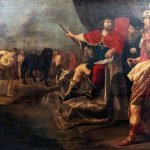Hispania was initially conquered on Carthage after winning by Rome Second Punic War. In 197 BCE, they were converted into two provinces: Upper Hispania (Hispania Ulterior) and Lower (Hispania Citerior). Later, the conquest of the country was rather sluggish. Subsequent battles took place in the years 154 – 133 BCE. In 123 BCE the Balearic Islands were also included in Nearer Spain.
Despite the apparent successes, the fighting in Spain dragged on. Caesar in 61 BCE suppressed the Lusitan rebellion, while in the years 39 – 19 BCE the goal was to ultimately subjugate these lands and consolidate them with the Empire, probably due to the administrative reform carried out by the emperor Octavian around 13 BCE. In place of the two old administrative units, three new ones were created: Hispania Baetica (formerly Ulterior) with its capital in Corduba, Hispania Tarraconensis (formerly Citerior) with its capital in Tarraco and the completely new province of Lusitania with its capital in Augusta Emerita.
At the end of the 2nd century CE troubles of all kinds began, as in the rest of the Empire: economic, social, military, and political. The clearest symptom of the crisis was the decline in population, which St. Cyprian: “there is a shortage of farmers in the fields, sailors at sea, soldiers in the camps”. One of the causes was the plague, another was the invasions of the Germanic tribes. The crisis of cities progressed and the role of large landed estates was increasing.
In the 3rd century CE, the emperor Caracalla introduced a new, short-lived division. He split Hispania Citerior into two parts again, creating Provincia Hispania Nova Citerior and Asturiae-Calleciae (today’s León). In 238 CE the provinces were reunified.
Major administrative changes in the province occurred during the reign of Diocletian when Spain became a diocese, consisting of six provinces: Lusitania, Gallaecia, Baetica, Tarraconesis, Carthaginiensis and Tingitania.
Spain, including North Africa, was a huge food store. Wool, olive oil, oil and wine were exported from there. A further increase in production occurred with the increase in field irrigation.
In addition to food, Spain supplied a number of raw materials: gold, iron, copper, tin and lead.
In the 5th century CE, the Pyrenees cross the Visigoths and the period of Visigoths Spain begins.








